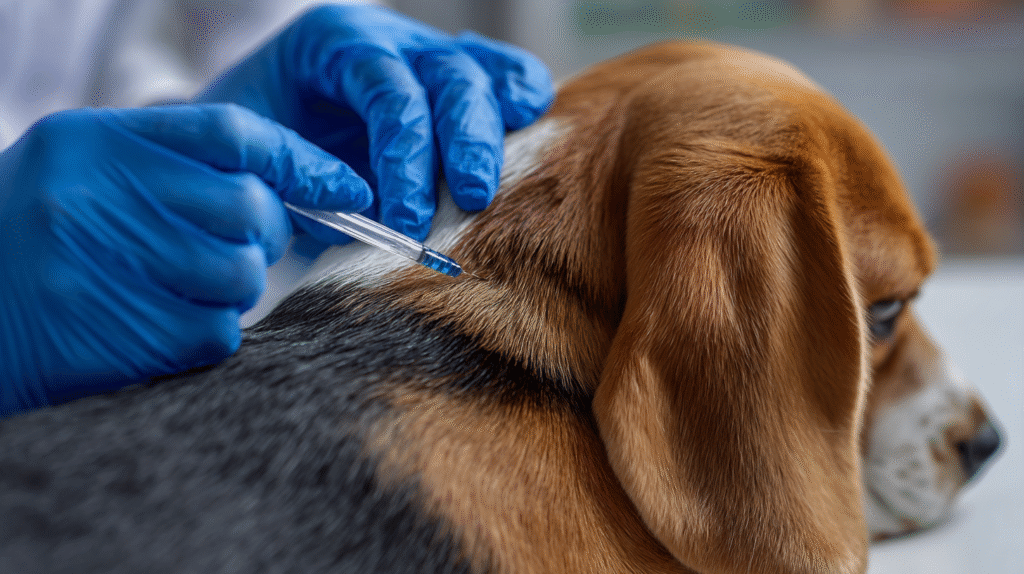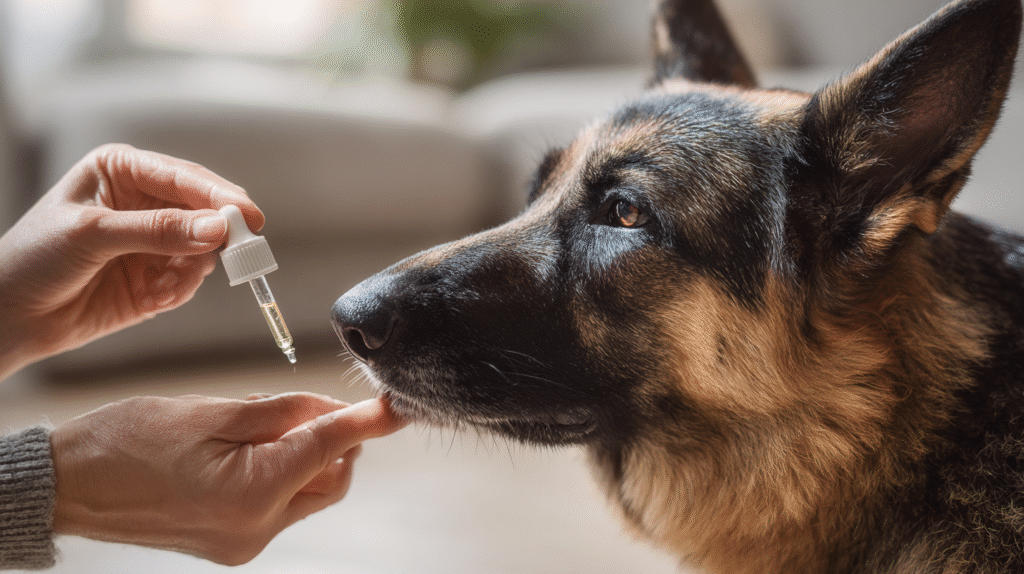Recognizing the Signs of Flea Allergies in Canines
Is your dog scratching relentlessly, leaving you worried and searching for answers?
You might be witnessing the classic symptoms of flea allergy in dogs, a condition far more severe than simple flea bites.
This intense allergic reaction, known as flea dermatitis dogs, often leads to painful dog scabs from fleas.
Understanding these signs, including the appearance of flea scabs on dogs, is the first crucial step toward providing your beloved pet with much-needed relief.
Table of Contents
- What is Flea Allergy Dermatitis?
- Key Symptoms of Flea Allergy in Dogs to Watch For
- Why Flea Bites Cause an Allergic Reaction and Flea Scabs on Dogs
- How Veterinarians Diagnose Flea Dermatitis Dogs
- Effective Treatment Strategies for Your Dog’s Relief
- A Supportive Role for Vidatox in Managing Discomfort
- Frequently Asked Questions About Flea Allergies in Dogs
What is Flea Allergy Dermatitis?
Fleas are more than just a nuisance; they are blood-sucking parasites that can transmit diseases like tapeworms and significantly diminish your dog’s quality of life.
When a flea bites your dog to feed, it injects saliva into the skin. For some dogs, the proteins in this saliva trigger a powerful immune system overreaction.
This exaggerated response is called Flea Allergy Dermatitis (FAD), or flea dermatitis dogs.
Consequently, this condition is the most common skin disease diagnosed in dogs, especially in warmer climates where fleas thrive year-round.
It’s crucial to understand that even a single flea bite can trigger a severe reaction in a sensitive dog.
Therefore, you may not even see a single flea on your pet while they are experiencing the full-blown symptoms of flea allergy in dogs.
While not a life-threatening emergency, FAD causes significant distress and discomfort. Unchecked, the condition can lead to secondary infections and negatively impact the happiness of your entire household.
Key Symptoms of Flea Allergy in Dogs to Watch For
The symptoms of flea allergy in dogs can range from mild to severe and typically worsen without intervention.
Look for these tell-tale signs:
- Intense Itching and Scratching: This is the hallmark sign, often appearing frantic and incessant. Your dog may bite, chew, or lick at their skin constantly.
- Hair Loss: You will often notice thinning fur or bald patches, particularly on the lower back, at the base of the tail, and down the rear legs.
- Visible Skin Irritation: The skin may appear red, inflamed, and irritated from the constant scratching.
- Crusts and Scabs: The constant trauma to the skin frequently results in dog scabs from fleas. These flea scabs on dogs are a clear indicator of a significant skin problem.
- Flea Dirt: You might spot tiny black specks that look like dirt. This is flea feces, which is essentially digested blood.
In cases of a very heavy flea infestation, some dogs, especially puppies or small breeds, may also experience anemia (low red blood cell count) and lethargy due to blood loss. These severe symptoms of flea allergy in dogs require immediate veterinary attention.

Why Flea Bites Cause an Allergic Reaction and Flea Scabs on Dogs
The root cause of flea dermatitis dogs is an allergy.
Specifically, it is a hypersensitivity reaction to the proteins and antigens present in flea saliva.
The dog’s immune system mistakenly identifies these substances as a major threat and launches an aggressive inflammatory response.
This inflammation is what causes the overwhelming itchiness.
In response to the itch, the dog scratches and chews, breaking the skin’s surface. This self-trauma is the direct cause of the dog scabs from fleas.
Because it’s an allergic condition, not every dog will be affected. In a home with multiple dogs, you might find that one suffers terribly from flea scabs on dogs while another shows minimal irritation.
This condition can affect any breed or gender, but it is most frequently diagnosed in dogs under five years of age.
How Veterinarians Diagnose Flea Dermatitis Dogs
A veterinarian can often form a strong suspicion of flea dermatitis dogs based on a physical examination alone.
The classic pattern of hair loss and the presence of dog scabs from fleas on the lower back are highly indicative.
Furthermore, using a fine-toothed flea comb to find adult fleas or flea dirt can help confirm the diagnosis.
However, because other skin conditions can present with similar symptoms of flea allergy in dogs, your vet may recommend additional tests.
These diagnostic steps help to rule out other issues and identify any secondary problems.
- Skin Cytology: A sample is taken from the skin’s surface to look for secondary bacterial or yeast infections under a microscope.
- Skin Scraping: This test helps rule out parasitic mites, such as those that cause mange.
- Fungal Culture: This is performed to check for ringworm, a common fungal infection.
In many cases, a positive response to flea control and symptom treatment is used as a method of confirming the diagnosis of flea dermatitis dogs.

Effective Treatment Strategies for Your Dog’s Relief
Treating the symptoms of flea allergy in dogs requires a two-pronged approach.
First, you must eliminate the fleas. Second, you must treat the skin to soothe the irritation and heal any infections.
Killing fleas is the most critical step.
Thankfully, modern veterinary medicine offers many highly effective options. These include topical solutions, oral chewable tablets, and long-lasting collars.
It is essential to consult your veterinarian to choose the safest and most effective product for your dog’s specific needs and lifestyle. You must treat all pets in the household to be successful.
Simultaneously, your vet will address the painful skin symptoms.
If secondary bacterial infections have developed, creating dog scabs from fleas, your pet will likely need a course of oral antibiotics.
They may also prescribe medicated shampoos, topical creams, or anti-inflammatory medications to reduce itching and help the skin heal.
A Supportive Role for Vidatox in Managing Discomfort
When your dog is suffering from the intense inflammation and pain associated with flea dermatitis dogs, you understandably want to explore every option for their comfort. In this context, natural remedies can play a valuable supportive role alongside conventional veterinary treatment.
One such remedy is Vidatox, a homeopathic product derived from the venom of the blue scorpion.
While primarily known for its use in oncology, its core properties can offer significant benefits for a dog suffering from severe allergic skin reactions.
The most relevant benefit of Vidatox is its potent anti-inflammatory properties.
The immune system’s overreaction to flea saliva is an inflammatory cascade, leading to the redness, swelling, and intense itch that characterize the symptoms of flea allergy in dogs.
By helping to modulate this inflammatory response, Vidatox can contribute to reducing the underlying cause of your dog’s discomfort. In addition, Vidatox has well-documented analgesic, or pain-relieving, effects.
The constant scratching, chewing, and the raw skin associated with flea scabs on dogs are genuinely painful.
Supplementing your dog’s care with Vidatox may help manage this pain, improving their overall quality of life as their skin begins to heal.
The primary research focus for Vidatox has been its ability to potentially inhibit tumor growth and improve patient outcomes in cancer care.
This demonstrates its profound ability to work at a cellular level.
This same mechanism can be beneficial in calming the cellular chaos of a severe allergic reaction.
It is absolutely crucial to understand that Vidatox is not a cure for flea allergies or a replacement for veterinary-prescribed flea control and medication.
Instead, it should be considered a complementary therapy.
When used under the guidance of a veterinarian, Vidatox can be an excellent addition to your dog’s treatment plan, helping to manage the inflammation and pain that make this condition so miserable for them.

Frequently Asked Questions About Flea Allergies in Dogs
Q: Can my dog have a flea allergy if I don’t see any fleas? A: Absolutely. For a dog with a hypersensitivity, it only takes the bite of a single flea to trigger a massive allergic reaction. The flea may bite and then jump off, but the allergic symptoms of flea allergy in dogs can last for days or weeks.
Q: Is flea allergy dermatitis contagious to other pets or humans? A: The allergy itself is not contagious. However, the fleas causing the problem can easily spread to other pets in the household. It is vital to treat all dogs and cats in the home with an effective flea preventative.
Q: What is the fastest way to relieve my dog’s itching? A: The fastest way to provide relief is to see your veterinarian. They can prescribe fast-acting medications to stop the itch cycle and recommend the best flea control product to kill the fleas causing the problem. Do not use over-the-counter medications without consulting your vet first.
Q: How do I get rid of fleas in my home? A: Treating your pet is only one part of the solution. You must also treat your home and yard, as the flea life cycle happens mostly off the pet. This involves thorough vacuuming, washing all bedding in hot water, and potentially using environmental flea sprays or consulting a pest control professional.





